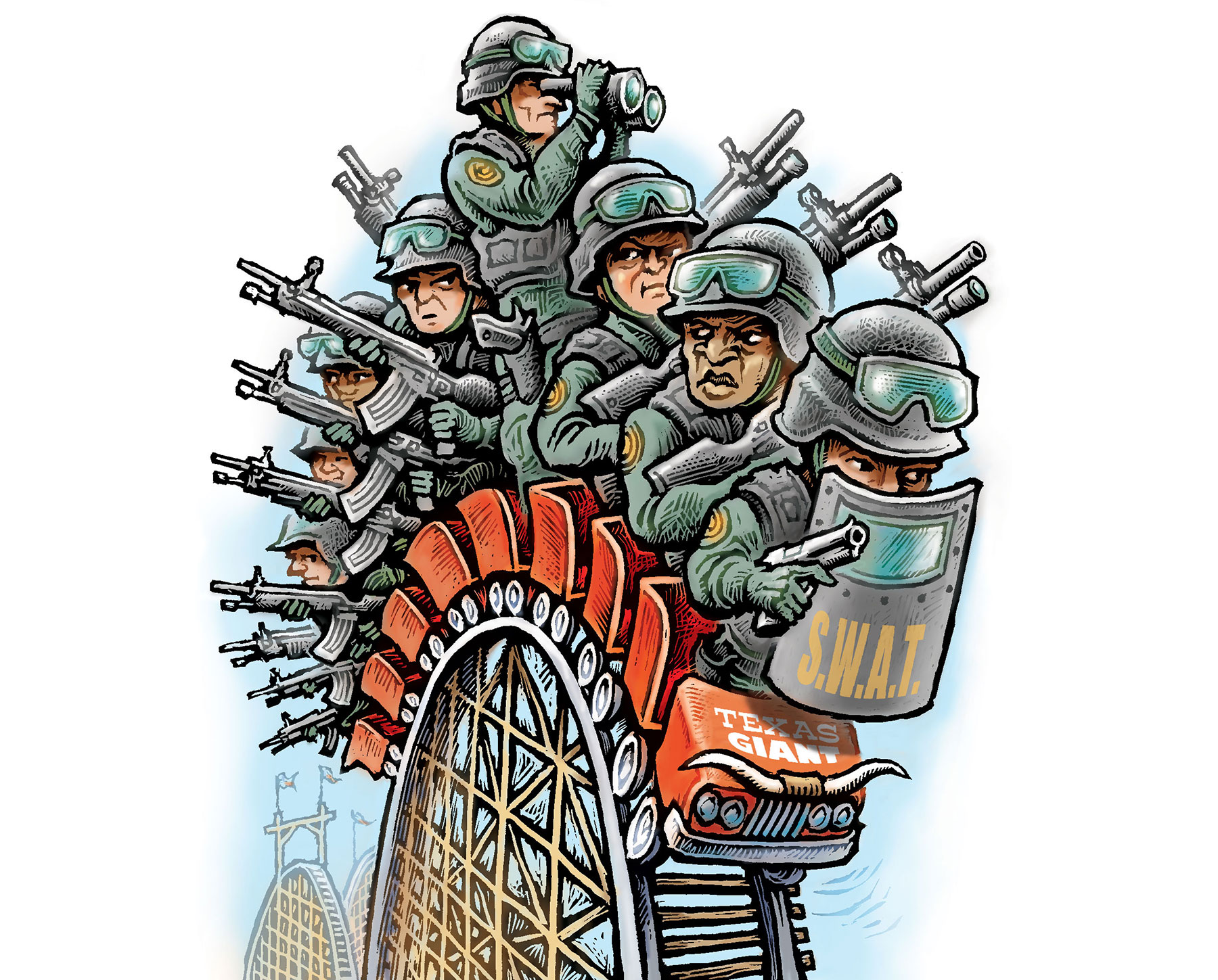I know an undercover cop who works in Tarrant County. He tells me many entertaining stories. My favorite is the one where the TCU girl obliviously walked into a hallway where a half-dozen cops were about to crash through an apartment door on a drug raid, and she screamed all the way to the parking lot. More relevant is a story about his recent interaction with the Arlington Police Department.
One day last summer, my friend’s undercover team meets with Arlington cops because they are about to help the team bust a capital-murder suspect who lives in that fine city. The undercover guys discuss how the team will drive to where the suspect is, meet back up with the Arlington cops, and execute the bust.
But when the undercover team arrives to nab the suspect, there’s no sign of Arlington backup. The Arlington cops are running just a few minutes behind, because, you know, Arlington streets are all pretzel-y, and Google Maps is a nightmare. This allows the suspect to speed away. The undercover team gives chase. Finally, the Arlington cops catch up! They make one small mistake, however. They pull over the undercover team, yelling at them with guns drawn, only to realize that the capital-murder suspect and his companions are not the guys yelling, “No, no, no! We’re the good guys! We were just in the meeting with you an hour ago! Remember?”
The bad guys, you may have guessed, got away.
I tell you this story not because I like to make fun of Arlington (which I do). I tell you so that you’ll understand how ill-prepared are the cops in Arlington, and in similar midsize to small cities, to engage in Jason Bourne-style derring-do. Most of them are, I’m sure, very good at day-to-day policing—issuing traffic tickets, breaking up domestic disputes, that sort of thing. But when operations get a bit more tactical, results may vary.
Imagine, then, what happens when these cops are given armored vehicles and military-grade weaponry, and are sent out as “soldiers” in a “war” against citizens. Now you have a picture of the SWAT teams in a thousand cities across the country. Now you know how a horde of Arlington SWAT cops could spend 10 hours last summer holding hippies at gunpoint, while their search for drugs or guns or anything turned up nothing. The Garden of Eden is a “new paradigm eco village” (read: hippie commune). After cops received complaints that hippies there were growing marijuana, Arlington’s finest soldier-cops raided the place. SWAT teams are often used in drug-warrant searches like this one. At the Garden of Eden, cops handcuffed eight people, including a mother of a toddler, while they searched the property. They didn’t find any drugs. However, executing a separate warrant, the city’s code-compliance office did find 20,420 pounds of “nuisance materials,” including compost, carpeting, tree limbs, and cardboard.
As a country, we’ve spent decades militarizing our special-tactics police units, turning them into fully equipped, poorly trained street warriors.
Elsewhere around North Texas, the Dallas County Constables oversee four SWAT-like “special response teams” that operate with little to no oversight. In 2009 alone, Frisco asked for funds to buy an armored vehicle and a mobile command vehicle, McKinney requested $5 million in SWAT-style goods, and old friend Arlington asked for $1.6 million in SWAT gear and to spend $130,000 for “covert ops.”
The escalation has been impressive. Los Angeles established the first well-known Special Weapons and Tactics unit in 1967 (possibly modeled on a Philadelphia program). It was intended to use light military equipment and advanced training to allow cities an adequate response to occasional high-drama conflicts (hostage situations, snipers, domestic terrorism). The idea caught on quickly. Today there are more than 1,000 U.S. police forces with SWAT or SWAT-type units (even DISD has one). According to Rise of the Warrior Cop: The Militarization of America’s Police Force (2013), paramilitary-style police raids have increased from a handful a day nationwide in 1980 to more than 100 a day.
I’m no libertarian alarmist, afraid the cops are out to get us. Generally speaking, I like government oversight, and I like cops. But it’s hard to argue that these small towns need tanks and armies to fight drug dealers.
Radley Balko, author of Rise of the Warrior Cop, thinks it’s impossible to defend the current level of police militarization. His book traces the long history of SWAT-style units and suggests that there are serious problems with them today. “There are a few good reasons for SWAT teams to be used,” Balko told me, “but only when it’s done as originally intended, to defuse a violent situation, not creating violence where there was none before. SWAT teams used to be reserved for use against someone in the process of committing a violent crime. Now they’re used all the time against people simply suspected of engaging in nonviolent crimes.”
I suggested to Balko that the problem isn’t so much in bigger cities like Dallas and Fort Worth, where you have larger pools of cops from which to choose your elite SWAT-unit officers. Balko said I’m wrong. It’s not about the police force’s size.
“Bigger cities may have well-trained officers, but their SWAT teams are still overused,” he said, citing statistics from his book and those kept by the ACLU in its ongoing project examining civil-rights violations stemming from the over-militarization of police. “Too often, even in big cities, they’re used to serve low-level drug warrants or break up poker games.”
A few years ago, some of the smaller towns in southern Dallas and northern Ellis counties (as well as Highland Park) realized the absurdity of trying to stock their own SWAT-style units and pooled resources. By forming a “mutual aid network,” they now share a SWAT-style response team, which seemingly will make them more reluctant to use the group unless there is an immediate, life-threatening need.
Balko says such multijurisdictional approaches still have problems, primarily that they lack the accountability and oversight needed to ensure they’re not misused. He also notes that until people stop viewing police militarization through political lenses—conservatives who laugh at organic-farm hippies being bothered, or liberals who shrug over concerns with the Branch Davidian siege in Waco—there is little chance of large-scale reform.
There are seeds of hope, however, for those who think the militarization has gone too far, including an off-the-record chat Balko had with a Texas state congressional aide who promised anti-militarization legislation next session. Until then, if you see guys in Kevlar vests and helmets and SIG556 assault rifles pull up in a tank, just run screaming for the parking lot.






